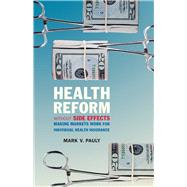
Note: Supplemental materials are not guaranteed with Rental or Used book purchases.
Purchase Benefits
What is included with this book?
Mark V. Pauly holds the position of Bendheim Professor in the Department of Health Care Systems at the WhartonSchool of the University of Pennsylvania. He received a PhD in economics from the University of Virginia. He is a professor of health-care systems, insurance and risk management, and business and public policy at the WhartonSchool and professor of economics in the School of Arts and Sciences at the University of Pennsylvania. Professor Pauly is a former commissioner on the Physician Payment Review Commission and an active member of the Institute of Medicine. One of the nation’s leading health economists, Pauly has made significant contributions to the fields of medical economics and health insurance. His classic study on the economics of moral hazard was the first to point out how health insurance coverage may affect patients’ use of medical services. Subsequent work, both theoretical and empirical, has explored the effect of conventional insurance coverage on preventive care, on outpatient care, and on prescription drug use in managed care. He is currently studying the effect of poor health on worker productivity. In addition, he has explored the influences that determine whether insurance coverage is available and, through several cost-effectiveness studies, the influence of medical care and health practices on health outcomes and cost. His work in health policy deals with the appropriate design for Medicare in a budget-constrained environment and the ways to reduce the number of uninsured through tax credits for public and private insurance. Pauly is coeditor in chief of the International Journal of Health Care, Finance, and Economics and associate editor of the Journal of Risk and Uncertainty. He has served on the Institute of Medicine panels on improving the financing of vaccines and on public accountability for health insurers under Medicare. He is an appointed member of the U.S. Department of Health and Human Services National Advisory Committee to the Agency for Healthcare Research and Quality.
| Foreword | p. vii |
| Acknowledgments | p. ix |
| Problem definition | p. 4 |
| The lay of the land: How many people have what problems? | p. 8 |
| Can individual insurance help? | p. 13 |
| Coverage for high risks | p. 19 |
| Community rating: the worst possible way to do a good thing | p. 23 |
| What's wrong with individual insurance? | p. 29 |
| What is good about the individual market? | p. 37 |
| How not to critique the individual health insurance market | p. 46 |
| Lowering administrative costs | p. 50 |
| Buying groups and exchanges: How many Chihuahuas equal a Great Dane? | p. 51 |
| Regulation and pricing without exchanges | p. 60 |
| Insurance company economics, sharp practices, premiums, and exclusions | p. 64 |
| Subsidies | p. 71 |
| What to hope for and what to expect | p. 75 |
| Offering the right product | p. 84 |
| The ideal and the feasible: compromises and mixes | p. 90 |
| Conclusion | p. 96 |
| References | p. 99 |
| About the Author | p. 103 |
| About the Hoover Institution Working Group on Health Care Policy | p. 105 |
| Index | p. 107 |
| Table of Contents provided by Ingram. All Rights Reserved. |
The New copy of this book will include any supplemental materials advertised. Please check the title of the book to determine if it should include any access cards, study guides, lab manuals, CDs, etc.
The Used, Rental and eBook copies of this book are not guaranteed to include any supplemental materials. Typically, only the book itself is included. This is true even if the title states it includes any access cards, study guides, lab manuals, CDs, etc.